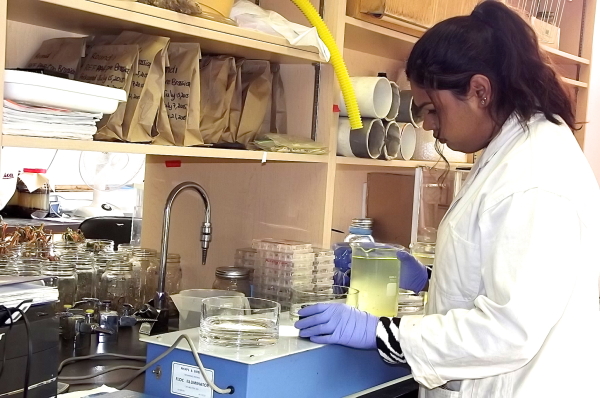Ryerson University’s solution-focused approach to water issues fits well with the Southern Ontario Water Consortium’s (SOWC) mandate to move innovations in water technology forward.
“Finding solutions and getting them out there as opposed to being purely academic is what sets us apart,” says Imogen Coe, Dean of the Faculty of Science. “We have developed strong and comfortable relationships with industry, municipalities, and not-for-profits. They identify problems and gaps and we identify and deliver the solutions.”
Located in the heart of Toronto, Ryerson’s expertise is centred around urban water issues.
“Urban water issues are becoming more important as the world becomes increasingly urbanized,” says Coe. “In order for cities to be sustainable and successful, we have to manage our water. The challenges cities face when it comes to establishing a healthy water cycle are numerous and Ryerson as an urban university is working to solve these problems.”
Some of the urban water issues include water withdrawal from watersheds, water destruction from floods, and decreased water quality, says Coe.
“We have a number of engineers working on infrastructure within the City of Toronto to help minimize the risk of flooding.”
After the City of Toronto invested billions in the municipal sewers to reduce flooding, the system still isn’t stemming the flow properly. Ryerson civil engineering professor James Li is researching cost-effective ways to improve water flow in the sewers and counter potential flooding, says Coe.
Another Ryerson civil engineering professor, Darko Joksimovic, is also developing innovative ways to reduce flooding in the city through low-impact tools such as permeable pavements in sidewalks and parking lots, she says.
“We also have architecture professor Hitesh Doshi who developed effective green roofs to reduce water flow to sewers and minimize flooding,” says Coe. “In fact, his research resulted in the City of Toronto implementing by-laws requiring green roofs on new builds.”
In addition to projects related to flooding, ecology professor Andrew Laursen is working with the municipality and industry to develop constructed wetlands to clean water naturally and inexpensively rather than with costly chemicals, Coe adds.
Although researchers at Ryerson have been investigating urban water issues for many years, in 2013 the university, under the leadership of Coe, officially brought experts under one roof by forming Ryerson Urban Water (RUW). RUW is a multidisciplinary group of close to 50 researchers with expertise ranging from science and engineering to business and public policy. The aim of the group is to develop cost-effective solutions that support a healthy urban water cycle while promoting innovation in water education.
One of RUW founding researchers, Lynda McCarthy, is connected with the SOWC’s ecotoxicology node. McCarthy previously worked at the Canada Centre for Inland Waters on Lake Ontario with the Department of Fisheries and Oceans Canada and Environment Canada. Her work has focused on issues related to the Great Lakes watershed such as real-time, early-warning bio-monitoring of drinking water, the impact of land-applied industrial and municipal biosolids, and the development of multi-biota protocols to supplement existing government protocols.

Researcher evaluating urban water samples in Dr. Lynda McCarthy’s research laboratory at Ryerson University (Photo Credit: Ryerson University)
Her work with SOWC involves the establishment of what she refers to as the ‘miner’s canary’ approach, which entails using aquatic organisms to measure water quality in real time. Through her work she has revealed that by observing the stress reactions of certain aquatic life in the aquatic environment, we can quickly determine if the water is healthy or not. The organisms used in this water assessment technique include green algae, euglena, zooplankters, benthic amphipods, larval insects and emergent macrophytes.
“You can tell a lot about the quality of the water just by looking at an organism’s stress behaviour,” says McCarthy. “For example when zooplankton are exposed to unhealthy water, they will go into a ‘deadman’s fall’ because they are stressed. Normally these organisms are happily swimming up and down in the water column in an erratic way so that predators can’t predict their movement. But when we put them in a toxic environment, they are still. They don’t go up and down because it requires too much energy and instead spend more time near the bottom. By watching their behaviour, we can tell in a heartbeat if the water is affecting them.”
Over the years, McCarthy has been fine-tuning this method in the lab and is currently using it to assess the potential impact from land-applying municipal biosolids on the receiving aquatic environment.
“This method is environmentally-relevant, sensitive, fast, cost-effective, accurate, and has broad applications,” says McCarthy. “To me, as an ecotoxicologist, it doesn’t get any better.”
The next stage in her research is to take what she has developed in the lab and test it out in the field using SOWC’s mobile field trailers. The trailers, which are part of SOWC’s ecotoxicology node, are designed to function as mobile laboratories to facilitate testing and exposure of multiple species to waste waters and contaminants within the watershed, including process streams from industries, municipalities, agriculture and other activities.
“For the last two decades, all of my research has been in the lab and now we need to get out in the field and get our organisms in the waste stream as it’s moving along,” says McCarthy. “Having access to the mobile trailers is vital because it’s how you get the most accurate waste stream. By the time you can grab effluent and bring it back to the lab, chemical changes can occur. With the mobile trailers, we can test the effectiveness of various treatment processes by observing the organisms’ reaction to the water right on site.”
McCarthy has plans to use the ‘miner’s canary’ approach to test the effectiveness of building wetlands next to the effluent pipes of industries as a way to help further treat the water.
“The use of the mobile field trailers has enormous potential in Toronto’s various watersheds,” says McCarthy. “One of the research studies underway at Ryerson is to ‘polish’ manufacturing wastewater at the source long before the effluent enters the sewer system using a strategy of engineered wetlands with advanced oxidation processes. Utilizing the ‘miner’s canary’ approach on-site to assess the wastewater improvement would provide a novel way to determine further remediation measures.”
The ultimate goal is to ‘polish’ the water further so that it can either be reused by the manufacturer or at the very least is cleaner once it gets to the wastewater treatment plant, she adds.
In addition to improving the quality of water used by industry, McCarthy also sees applications of her ‘miner’s canary’ approach to test the effectiveness of various treatment processes at municipal wastewater treatment plants.
McCarthy’s work is an example of the many projects Ryerson researchers are conducting that involve incorporating novel ways of solving water issues facing municipalities and industry, says Coe.
“As a result, Ryerson experts know what will work when it comes to introducing new water technologies to the market.”


